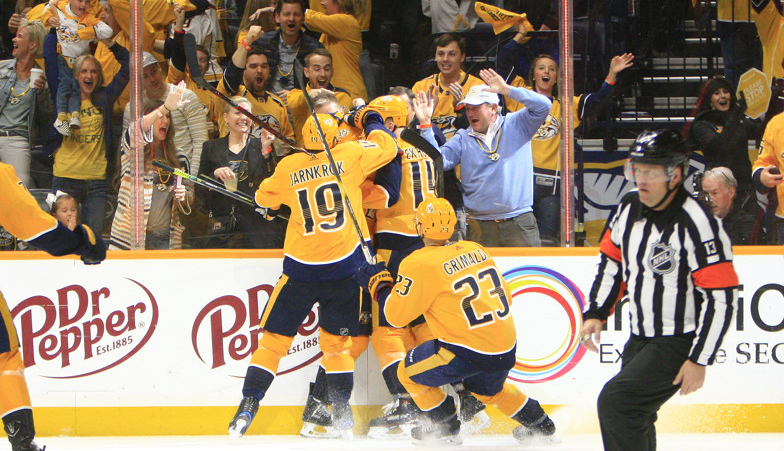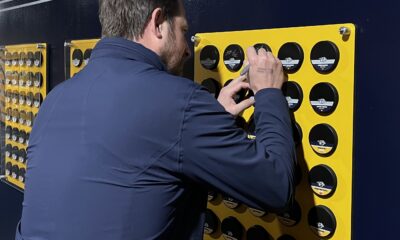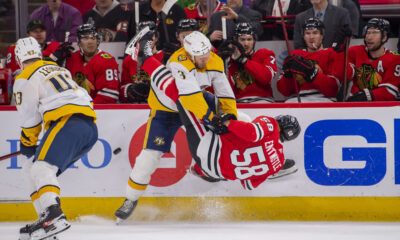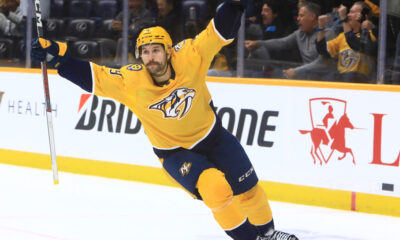
When Matt Duchene was signed with the Nashville Predators, most speculated that Kyle Turris would center the third line. Sure enough, the 30-year-old veteran paired with Calle Jarnkrok and Rocco Grimaldi on the third line when the Predators hit the ice against the Minnesota Wild. When this line was in the offensive zone, Turris dished the puck to the middle of the slot on four separate occasions. Neither Jarnkrok nor Grimaldi was there to bang it home.
Not ideal.
Looking beneath the third line, Colton Sissons, Nick Bonino, and Austin Watson manned the fourth line. Although they each notched a point in the first three games, this line was not intended to carry a scoring weight; moreover, their jobs reside in the defensive, shut-down territory. Unfortunately, the only player who truly lives up to that role is Colton Sissons (probably why he was signed for seven more years). Altogether, Grimaldi, Watson, Bonino and Jarnkrok have put together an unimpressive stat line over the course of three games, and there’s not much evidence to think it’ll improve. However, the line combinations are not subject to change.
Here are a couple of thoughts on why the bottom six will remain the same, despite a need for change.
1. The Past
For some reason, David Poile and Peter Laviolette love players who outperform their true abilities in tight situations, as in the recent examples of Frederick Gaudreau and Miikka Salomaki.

Frederick Gaudreau, an average AHL player, dominated the latter half of Nashville’s 2016-2017 playoff run, scoring his first three goals as an NHLer in the Stanley Cup Playoffs. Gaudreau’s encore in the 2017-2018 was remarkably disappointing, as he posted three points in twenty games. He then followed that season with an even more disappointing year in 2019, scoring four points in fifty-five games. Nevertheless, Gaudreau tightened his skates fifty-five times because his name appeared on the lineup, despite some uninspiring statistics.
Miikka Salomaki managed to grab Laviolette’s attention before the Predators entered the 2017-2018 playoffs, as he played on the fourth line over Scott Hartnell, a move that arguably cost the Predators in the second round. Salomaki has always been a depth forward but that does not mean he should not contribute offensively as well. His role is that of a bruiser, but bruisers should be scoring more than seven points in the regular season.
It would appear upper management really wanted these two players to shine on the brightest stage, but that plan did not pan out. Both players were placed on waivers, and now they’re back in Milwaukee.
Much like Salomaki and Gaudreau, Calle Jarnkrok and Austin Watson have earned enough credibility to stay in the lineup. Comparatively speaking, Watson and Jarnkrok are better than Salomaki and Gaudreau, but are they playing to the caliber they’re truly capable of?

Calle Jarnkrok scored nine points in twelve games when he debuted as a Nashville Predator. Since then, he’s been a steady 30-point getter with defensive capabilities. Austin Watson lacks the ‘scoring touch’ of Calle Jarnkrok, but he’s reliably contributing around 20 points a year. Throw in Nick Bonino, a 31-year-old, two-way forward who hovers between 25 and 40 points a year, and one would think that the Predators have a solid fourth line. But most of the scoring from these players is lucky; catching the goaltender off guard or touching a puck while lying on the ice (see Watson’s first goal of the year) or suddenly shooting a career-high 14.4% and sniping 17 goals with only a 46.83 HDCF% (see Bonino’s regular season stat line in 2018-2019) seems pretty indicative of how truly offensively inclined these players are.
Rocco Grimaldi, a player who surprised everyone in the postseason last year, resigned with the team after the arbitration process. Despite the lengthy negotiation, the Predators were very clear and upfront about wanting Grimaldi back on the team. For a guy with only 30 NHL games and nine NHL points to his name prior to signing with Nashville, Grimaldi earned a pretty handsome payday after merely one productive playoff series. One hopes that Grimaldi will not follow in the footsteps of Gaudreau and be a point-getter this year. Although Grimaldi’s experience does not match Jarnkrok’s, Bonino’s, or Watson’s experience, it’s extremely hard to say that these players can manufacture their own production as any of the top six can.
Consistency in the bottom six is not something to disregard by any means, but the Predators are in an odd situation: they have run out of room in the top six to put all of their playmakers.
2. What If?
Let’s wind the clocks back for a brief moment.
What if I told you that Nick Bonino would be the difference maker in the Nashville/Pittsburgh SCF? What if I told you that Calle Jarnkrok would be the leading point getter for Nashville in the same Pittsburgh series? What if I told you that Austin Watson would score two goals in the previous series’ deciding game, propelling Nashville to the SCF? What if I told you that Rocco Grimaldi outscored Viktor Arvidsson in the most recent Dallas playoffs series?
You probably wouldn’t have believed me.

Granted, Grimaldi’s situation is a little different- he has one year to prove his ability to replicate his playoff performance last year, but he’s still in the bottom six and still vying to make an impact. Full disclaimer, Grimaldi can be an energy guy on the fourth line. However, as seen in game one of the regular season, when Ryan Hartman knocks him out of his skates early in the game, one can see how difficult maintaining energy can be.
Nevertheless, at the climax of Nashville’s quest for the cup, the team is relying on bottom six players who cannot sustain consistent production, both offensively and defensively. Crassly speaking, wondering how many goals Arvidsson and Forsberg will score per week versus how many goals these four players will score per month is upsetting but virtually similar.
But what if they suddenly start scoring and producing as they did in the playoffs?
Considering heroics bring most fans to the game over analytics, one might say the regular season stats do not matter; admittedly, these four players have been noticeable in the recent playoffs. But, with all of the hype around the Smith-Johansen-Arvidsson and Forsberg-Duchene-Granlund lines, teams are almost certainly formulating a plan to shut them down, and who is left, besides Kyle Turris and Colton Sissons, to pose a legitimate threat? Nashville cannot reasonably rely on ‘what if these players step up?’
3. Janet Jackson & Money
WHAT HAVE YOU DONE FOR ME LATELY?!
Allow me to clarify: what have these four players done to help the team going forward? Is the cap space they’re occupying worth the low production?
Last year, these four players contributed 90 points in the regular season. Compared to the top line, featuring Arvidsson-Johansen-Forsberg who scored 148 points, those aren’t bad numbers at all. Grimaldi and Watson did not play close to a full season, so Bonino and Jarnkrok hauled in the most out of those four. Here’s how they faired in terms of points per game.
- Bonino- .43 (35 points in 81 games)
- Watson- .43 (16 points in 37 games)
- Jarnkrok- .33 (26 points in 79 games)
- Grimaldi- .24 (13 points in 53 games)
At the end of the season, those numbers are pretty solid for bottom six forwards. Bonino was a pretty stable scorer, but he was arguably the luckiest forward on the Nashville roster last year. Jarnkrok scored 10 times the rest of the year following a four game point streak in January. Watson was really hot coming off his suspension, cooled off for about two months, picked up some points before his second suspension, then picked up some more points when he returned. Grimaldi did not play the last two weeks in the regular season, and scored quite infrequently.
According to CapFriendly, these four players occupy approximately $8,200,000 combined in cap space. With a looming Roman Josi extension (where he will ASSUREDLY be paid Erik Karlsson money) and the uncertainty surrounding Craig Smith and Mikael Granlund’s contracts, Nashville will have to move some pieces around. Additionally, these four players are perfect candidates to free up some space if they want to bring some fresh talent to Nashville. For the time being, the Predators are sticking with what they know.
But are they REALLY worth that much money?
To put this into perspective, Patrick Maroon brought 28 points and playoff heroics to the Stanley Cup Champion Blues team last year. He made $1.75 million, then signed for $900,000 this year with the Tampa Bay Lightning. Last year, Calle Jarnkrok hauled in 26 points with no playoff heroics, and will make $2 million for the next three years. Even Bonino, whose contract is worth $4.1 million, scoring only 35 points is slightly unreasonable.
As much as money as he’s making and from what he’s displayed in the past, Jarnkrok should be much better than 26 points a year. Out of the four, he has the highest scoring ceiling but has disappeared ever since he netted that hat trick against the L.A. Kings last year. Scoring 10 times in four months is not ideal, especially for a guy who should be scoring around 40 points a year.
These players are paid to produce and asking them to carry some of the scoring burden isn’t vexatious. As a matter of fact, if they do not produce this year, they should be let go. Likewise, IF they do start producing, then they should be kept in the lineup, but recent trends imply that they probably won’t.
4. Pekka Rinne is Running Out Of Time
Pekka Rinne will almost certainly retire at the end of the 2020-2021 season, and his retirement could mean the closing of Nashville’s Cup window. Juuse Saros, who is a solid goaltender, will definitely have massive skates to fill, and being the rock that Pekka Rinne has been for the Predators is almost impossible.
If Nashville weren’t picks to win the Stanley Cup, maybe it would be time to sell out and bring Eeli Tolvanen and Rem Pitlick into the mix. Probably Jeremy Davies too, but that third defensive pairing is another story.
I’ve mentioned this before, but David Poile would be out of his ever-loving mind if he weren’t trying to win this Cup for Pekka Rinne. He’s been the backbone of the team (see what I had to say about him here) for the longest time and deserves the Cup more than anyone on this Nashville roster. And unfortunately, he is almost out of time. One of my good friends, Eamon Smith, mentioned in his latest recap, “Poile continues to roster poor players over young talent that could objectively improve the lineup.” (it’s funny because we did not know about each other’s love for hockey until senior year. We attended twelve years in education together and only recently really started talking last fall).
Eamon is absolutely correct, but the biggest reason they’re not in Nashville right now is that experimentation could prove devastating. Tolvanen and Pitlick are top to middle six players, and hockey isn’t a linear progression. Miikka Salomaki will not be on the first line in Milwaukee because he’s a bottom six forward, and bottom six forwards are not meant to start on the first line. Alternatively, placing Tolvanen and Pitlick in Nashville’s bottom six could inhibit their progression as Nashville’s potential top six forwards and, if they don’t produce, could be wasting their time.
Still, it’s hard to imagine Tolvanen and Pitlick not being successful with Kyle Turris centering them. Let’s also not forget Daniel Carr, who has been scratched for three games, and looks to get his first game action against Washington.
My point is this: Nashville does not have time to see if Tolvanen and Pitlick are ready to go. That’s why they’ll be playing top six minutes in Milwaukee. The Predators might have a solution in Daniel Carr should production not increase, but Jarnkrok, Bonino, Watson, and Grimaldi are safe bets. There’s a disappointing awareness of their abilities, but feeling safe often alleviates worries and destroys opportunities at the same time.
5. Stats, Because, Stats.
Frankly, the sample size for offensive production is too low to determine how the rest of the season will play out. This season is the first time Rocco Grimaldi has played with Kyle Turris consistently, and Calle Jarnkrok’s play with Turris last year was minimal. Theoretically, they’re another scoring line, but they have not produced to that level yet. Kyle Turris is dragging that line with him. Over three games, here is the current trend for expected goals for. Once again, this is an extremely small sample size and will optimistically improve over the course of the season.
- Turris’s xGF% with Jarnkrok: 55.48%
- Turris’s xGF% with Grimaldi: 53.49%
- Turris’s xGF% without Jarnkrok: 43.76%
- Turris’s xGF% without Grimaldi: 46.74%
- Jarnkrok’s xGF% without Turris: 17.36%
- Grimaldi’s xGF% without Turris: 10.94%
One might say three games may not reflect the other 79, and I’d agree. Just based on what has taken place on the ice so far, here’s the most fair observation I can make about the Turris line.
Jarnkrok is helping more than Grimaldi, but overall, it would appear Turris is playing steadily and creating chances without them, whereas Jarnkrok and Grimaldi are not playing well without Turris. There are a lot of confounding variables, like Turris adjusting to third line minutes or Grimaldi skating with an entirely new line. Some contingencies might be a line change or an injury, but this line should theoretically play well together, and so far, only Turris is doing so.
Grimaldi was awarded with a primary assist on Turris’s first goal against San Jose, but Turris had eluded past the San Jose defender, making his streak to the net easy and almost unavoidable. Considering Grimaldi’s pass wasn’t crisp, Turris made the most of what he was given. Whatever works though, right?
Offensive stats do not necessarily reflect the role each player on the team has, but it’s safe to assume the Bonino line is not meant to score goals. All three players on the Bonino line are also on the PK, and judging their recent performance on offensive metrics would make them look bad. With that in mind, Colton Sissons recorded his first point on a defenseman goal, not his linemates. When Nashville’s fourth line and the first defensive pairing are on the ice together, it is obvious the defensemen are more capable of scoring goals than the forwards.
So Where Does That Leave Them?
It puts Nashville back where they were last season. Matt Duchene and Mikael Granlund are the biggest improvements so scoring from the “second line” will not be an issue.
The bottom six will be a scoreless inquiry, but these lines will have to do for the time being. If Nashville finds themselves in a position later in the year where something needs to drastically change, expect to see Rem Pitlick and Eeli Tolvanen in the mix. If Nashville is stably winning in January, expect nothing to change.
One more thing.
“What Have You Done For Me Lately?” is still a terrible song.













